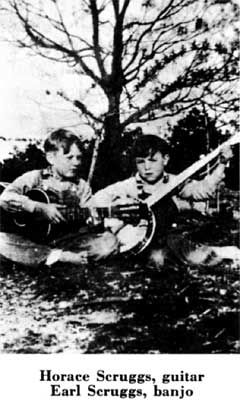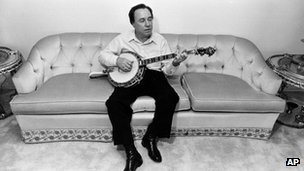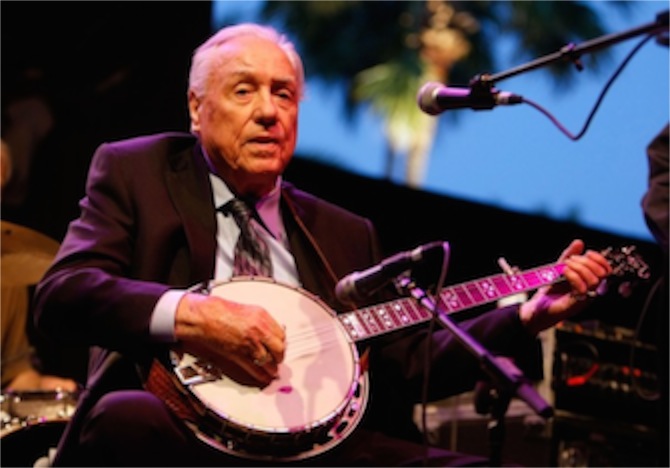Y'all come back now
29/03/12 05:18
Earl Scruggs was born in Cleveland County, North Carolina. His daddy, George Elam Scruggs was a farmer and a bookkeeper. He was also a fiddle player. His momma, Lula Ruppe Scruggs, played the organ. He was the fifth child. His older brothers, Junie and Horace, and his older sisters, Eula Mae and Ruby, all played he banjo and guitar. He was born into a musical family. But he was also born to a place where music was the only form of entertainment. Music is what they did to keep their spirits up in really tough times. He once said, “My music came up from the soil of North Carolina.” And times were about to get much harder.
 Earl’s daddy died after a long illness when the boy was only four years old. As an adult, Earl said he could remember his daddy, but not his daddy playing the banjo. Still, the boy picked up the banjo around the time of his father’s death. He started playing Junie’s banjo or the one his father played. He was so small that the only way he could play the thing was to sit on the floor with the body of the banjo to his right. He’d slide the instrument around quite a bit, depending on what position on the neck he was attempting to play. He started out with his own self-taught two-finger picking style.
Earl’s daddy died after a long illness when the boy was only four years old. As an adult, Earl said he could remember his daddy, but not his daddy playing the banjo. Still, the boy picked up the banjo around the time of his father’s death. He started playing Junie’s banjo or the one his father played. He was so small that the only way he could play the thing was to sit on the floor with the body of the banjo to his right. He’d slide the instrument around quite a bit, depending on what position on the neck he was attempting to play. He started out with his own self-taught two-finger picking style.
The nation spiraled toward the Great Depression. Earl’s family struggled to have enough food to put on the table. Earl was the baby. He was allowed the opportunity to play, though there wasn’t much in the way of toys. No matter, Earl preferred the banjo for every moment that he was allowed to escape from chores or school. By the time he was 10 he got his own banjo – a $10.95 Montgomery-Ward mail order model. It was on that banjo that he developed the three-finger style that launched the rebirth of the traditional instrument. To this day the style is known as “Scruggs-Style Picking.” The style of picking that he developed wasn’t heard anywhere else except in that small region in North Carolina. Nobody played it any better than Earl. He could emphasize the melody while ornamenting it with rolls and melody. The thumb, index and middle fingers of his right hand moved so fast that other players couldn’t even observe, let alone imitate his style.
 By 1945, Earl was playing a Gibson RB-11 banjo with Bill Monroe’s Blue Grass Boys. That is where he met Lester Flatt. Scruggs and Flatt left the band and formed the Foggy Mountain Boys in 1948, but the band was mostly known simply as Flatt and Scruggs until 1969 when Earl and his sons formed the Earl Scruggs Revue.
By 1945, Earl was playing a Gibson RB-11 banjo with Bill Monroe’s Blue Grass Boys. That is where he met Lester Flatt. Scruggs and Flatt left the band and formed the Foggy Mountain Boys in 1948, but the band was mostly known simply as Flatt and Scruggs until 1969 when Earl and his sons formed the Earl Scruggs Revue.
If you don’t know anything about country music, you know the music of Earl Scruggs. Think of the music during the car chases in the movie “Bonnie and Clyde.” Think “The Ballad of Jed Clampett” from the TV show, “The Beverly Hillbillies.” The song was played at the beginning and the end of every episode. Flatt and Scruggs appeared in several episodes, always playing the part of friends of the Clampett family.
Here is what I remember: In 1969, he played “Foggy Mountain Breakdown” on an open-air stage in Washington D.C., at the Moratorium to End the War in Vietnam. There weren’t many bluegrass or country-Western artists in the anti-war movement. They were more likely to ascribe to the “fly the flag and support the troops” position. Earl said: “I think the people in the South is just as concerned as the people that’s walkin’ the streets here today . . . I’m sincere about bringing our boys back home. I’m disgusted and in sorrow about the boys we’ve lost over there. And if I could see a good reason to continue, I wouldn’t be here today.”
That song, “Foggy Mountain Breakdown” won Scruggs a Grammy that year. It was instrumental in assuring him a place in the Country Music Hall of Fame, a National Heritage Fellowship, a National Medal of Arts, and a spot in the International Bluegrass Hall of Honor. He has a star on the Hollywood Walk of Fame. There are so many honors earned over the years that it is difficult to compile the whole list.
 And what he loved best was making music with other folks. Over the years he recorded with Doc Watson, John Fogerty, Elton John, Sting, Johnny Cash, Don Henley, Travis Tritt, Billy Bob Thornton and many others. He played with Vince Gill and Albert Lee on electric guitar, with Paul Shaffer on the piano, with Leon Russell on the organ, and Marty Stuart on mandolin. He even played with Steve Martin.
And what he loved best was making music with other folks. Over the years he recorded with Doc Watson, John Fogerty, Elton John, Sting, Johnny Cash, Don Henley, Travis Tritt, Billy Bob Thornton and many others. He played with Vince Gill and Albert Lee on electric guitar, with Paul Shaffer on the piano, with Leon Russell on the organ, and Marty Stuart on mandolin. He even played with Steve Martin.
Earl’s wife was also his manager and they formed a great team until she died in 2006 after a long illness.
Yesterday, the 60+ year performing career came to its end. Earl died in a Nashville hospital of natural causes. He was 88 years old.
He may have died, but the music continues. Sons Gary and Randy are both musicians. Another son, Steve, was a drummer but died tragically in 1992. The music will also continue in generations of banjo players who will play his recordings as they attempt to master that three-finger style. And Earl wouldn’t want the world to keep listening to the same old songs played over and over. While he was a champion of traditional music and certainly excelled playing the classics, Earl was always looking for new sounds. “If you don’t let things develop, it’s like keeping something in a bag and not letting it out to fly,” he said in 2000. “There’s so many different types of music that you can put together to come up with a fresh sound. So that’s been the whole thing, to try to play something that sounded good. You never know until you try it out.”
You’ll never know until you try it out. Earl’s trying out new tunes in a new place these days. I’m betting it’s a fresh sound. And I know it sounds real good.
Thanks, ol’ Banjo picker. The music has been great!

The nation spiraled toward the Great Depression. Earl’s family struggled to have enough food to put on the table. Earl was the baby. He was allowed the opportunity to play, though there wasn’t much in the way of toys. No matter, Earl preferred the banjo for every moment that he was allowed to escape from chores or school. By the time he was 10 he got his own banjo – a $10.95 Montgomery-Ward mail order model. It was on that banjo that he developed the three-finger style that launched the rebirth of the traditional instrument. To this day the style is known as “Scruggs-Style Picking.” The style of picking that he developed wasn’t heard anywhere else except in that small region in North Carolina. Nobody played it any better than Earl. He could emphasize the melody while ornamenting it with rolls and melody. The thumb, index and middle fingers of his right hand moved so fast that other players couldn’t even observe, let alone imitate his style.

If you don’t know anything about country music, you know the music of Earl Scruggs. Think of the music during the car chases in the movie “Bonnie and Clyde.” Think “The Ballad of Jed Clampett” from the TV show, “The Beverly Hillbillies.” The song was played at the beginning and the end of every episode. Flatt and Scruggs appeared in several episodes, always playing the part of friends of the Clampett family.
Here is what I remember: In 1969, he played “Foggy Mountain Breakdown” on an open-air stage in Washington D.C., at the Moratorium to End the War in Vietnam. There weren’t many bluegrass or country-Western artists in the anti-war movement. They were more likely to ascribe to the “fly the flag and support the troops” position. Earl said: “I think the people in the South is just as concerned as the people that’s walkin’ the streets here today . . . I’m sincere about bringing our boys back home. I’m disgusted and in sorrow about the boys we’ve lost over there. And if I could see a good reason to continue, I wouldn’t be here today.”
That song, “Foggy Mountain Breakdown” won Scruggs a Grammy that year. It was instrumental in assuring him a place in the Country Music Hall of Fame, a National Heritage Fellowship, a National Medal of Arts, and a spot in the International Bluegrass Hall of Honor. He has a star on the Hollywood Walk of Fame. There are so many honors earned over the years that it is difficult to compile the whole list.

Earl’s wife was also his manager and they formed a great team until she died in 2006 after a long illness.
Yesterday, the 60+ year performing career came to its end. Earl died in a Nashville hospital of natural causes. He was 88 years old.
He may have died, but the music continues. Sons Gary and Randy are both musicians. Another son, Steve, was a drummer but died tragically in 1992. The music will also continue in generations of banjo players who will play his recordings as they attempt to master that three-finger style. And Earl wouldn’t want the world to keep listening to the same old songs played over and over. While he was a champion of traditional music and certainly excelled playing the classics, Earl was always looking for new sounds. “If you don’t let things develop, it’s like keeping something in a bag and not letting it out to fly,” he said in 2000. “There’s so many different types of music that you can put together to come up with a fresh sound. So that’s been the whole thing, to try to play something that sounded good. You never know until you try it out.”
You’ll never know until you try it out. Earl’s trying out new tunes in a new place these days. I’m betting it’s a fresh sound. And I know it sounds real good.
Thanks, ol’ Banjo picker. The music has been great!